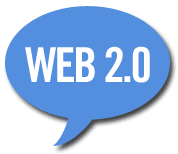
We have all heard the term “Web 2.0”. What does it mean, and how did the regular web evolved to this version?
The traditional Web formula has been static Web pages, where users take a passive ‘reading’ role when accessing sites. Web 2.0 is a collection of services that allow, among many things, greater community participation, content syndication, advancements in Web-based user interfaces, and a new breed of Web services that create an entirely new application platform.
Overall, dynamism and community. The regular user might say that this change was unavoidable and came by itself as a natural evolution. It’s not really like that.
Have you noticed the stickiness turning into syndication with RSS feeds? The online encyclopedias turning into Wikipedias where everyone can give their contribution? How about the personal websites turning into blogs? The web technique called domain name speculation that tried to anticipate the domain names turned into a totally new technique – SEO (Search Engine Optimization) that’s being developed worldwide.
Wikipedia defines Web 2.0 as “a phrase that refers to a supposed second generation of Internet-based services—such as social networking sites, wikis, communication tools, and folksonomies—that emphasize online collaboration and sharing among users. O’Reilly Media, in collaboration with MediaLive International, used the phrase as a title for a series of conferences and since 2004 it has become a popular (though ill-defined and often criticized) buzzword among certain technical and marketing communities.”. I totally agree.
The main characteristics of web 2.0 are: applications integrated within web browsers, users contributing to a website’s content and a rich, interactive, user-friendly interface based on Ajax or similar frameworks.
Few websites are still using the 1.0 concept, and if they do, they’re not among the popular ones. How did the Web 2.0 integration affect you?